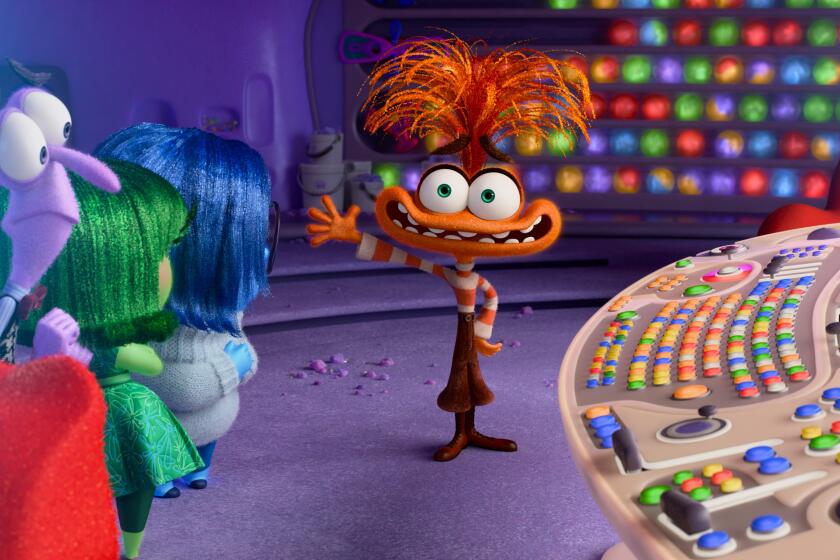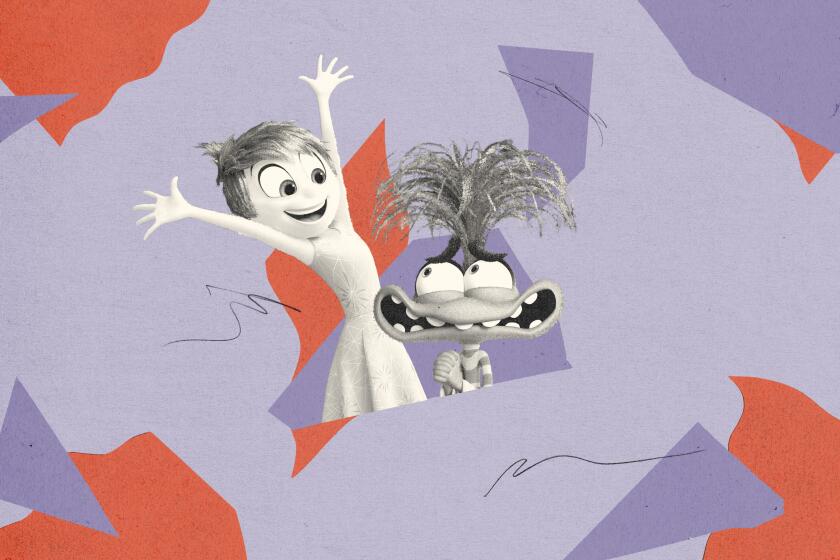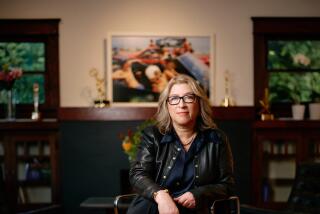- Share via

Kelsey Mann was scanning some old photos when he came to a series of pictures from his childhood birthdays and was struck by what he saw.
“I was 5, and it’s my birthday, and I’m sitting there in front of my cake … I think it was the smile and the joy on my face that made me stop,” says the director of “Inside Out 2.” “I’m like, ‘Wow, I am really enjoying the hell out of this moment.’ Then I turned 8, and my smile went down. I turned 11; it went down even further. Then 13, and I’m just staring at this cake, wishing I was anywhere but there.
“So I thought, ‘What the hell happened?’ ”
“Inside Out” had been a huge hit for Pixar in 2015. The comedy about 11-year-old Riley’s emotions, led by Joy, struggling to find balance within her grossed more than $850 million and won the animated feature Oscar. Naturally, with a sequel in mind, the studio’s writers had been continuing to learn how the mind works.
“A lot of us [were] doing the research of what goes on in the brain — suddenly, I — ‘Oh, I understand what I was doing,’ ” Mann says of the change in his photos. “This is the time when you become really self-conscious and compare yourself to others. … I hated the attention. I just wanted it to be over. So that feeling of not feeling good enough is where a lot of this began.”
Once again, we’re in the head of Riley, whose interior console needs to make room for new emotions, voiced by Maya Hawke, Ayo Edebiri and Adèle Exarchopoulos.
“Welcome to Pixar,” says “Inside Out 2” co-writer Dave Holstein, to laughter from Mann and co-writer Meg LeFauve, over a video chat. “We start at the emotional core and we think, ‘What’s the saddest possible thing?’ ”
They laugh again, but this is the studio that traumatized us all with the opening sequence of “Up.” And for “Inside Out 2” — also nominally a comedy — they were steeped in one of the most terrifying circumstances: puberty. In the sequel, now-13-year-old Riley is doing great, playing hockey with good friends. Her now-united emotions, led by Joy (voiced again by Amy Poehler), are nurturing her developing Sense of Self. Then a whole squad of new emotions, powered by the frantic energy of Anxiety (Maya Hawke), arrives and throws everything off kilter.
Holstein says, “When Kelsey was discussing that seed of this idea, I think the question that came up for me was, ‘What happens to joy as we get older?’ ”
LeFauve says, “Perfectionism and anxiety taking over at that age is something that we could all relate to … [but] it also had to be fun. You want to be true and authentic to the research and human beings,” she says of wanting the film to be relevant to teenage girls like the ones in the story.
But with all the input from different places and the different plot threads involving Riley’s struggles to fit in at hockey camp, Anxiety’s misguided attempts to help, exiled Joy’s quest to return and restore balance and all the “balls in the air” and “three-dimensional chess,” as LeFauve puts it, Mann would keep coming back to the central idea: “ ‘What’s the story? This is about Joy.’ ”
“There’s a real ‘Inception’ quality to writing an emotional arc for an emotion inside someone else’s head while thinking about it in your head,” Holstein says with a chuckle. “So it is like three-dimensional chess, but played on a Chinese checkerboard during a game of Clue inside a dishwasher.
“The first movie, to me, was Joy discovering the power of Sadness,” Holstein adds. “And this movie, for me, had to be Joy discovering the power of Joy.”
They didn’t have to go far to find subjects for research. During COVID-19 closures, they got to see kids up close every day at home. But LeFauve didn’t even have to look that far to get started.
“I suffered from anxiety as a teenage girl,” she says. “So I was very much drawing from my own experience and how isolating that can be, especially in all the social things going on. As an adult, I found the solution of asking Anxiety to take a seat and to say, ‘I’m not going to die.’ ‘Give her a job.’ I do want teenagers to know you can ask anxiety to take a seat. It really does work. Give her a job. She needs a job. It’s not a piece of yourself you can cut out or get rid of. When I have my anxiety, I say, first, “Thank you. I know you’re trying to protect me.” She’s a part of me. She’s a part I need, but you can take a seat. I’m OK.”
The animation business is facing a question that ‘Inside Out 2,’ ‘Moana 2,’ the Minions and Garfield can’t answer: What’s going on with animated originals at the box office?
LeFauve had other personal experience to rely on as well. “I have a son who has anxiety, so he would constantly be telling me about the projections of the future, and ‘What if?’ It helped to give him the clarity of, ‘But is that happening?’ It’s what Joy is saying in that sequence. So a lot of the sequences came from my experience as an anxious teen and adult and as a mom with an anxious teen.”
Often, the adults learned from the kids. Mann says his daughter’s leanings toward perfectionism have caused her some anxiety.
“A lot of what my daughter has been able to learn, I’ve been able to learn from and put in the movie — the whole panic-attack scene at the end,” he says. “[Riley’s] having one and starts to come down out of it; she’s using her senses in order to ground herself in the present. … It’s a technique I learned through my daughter.”
Holstein, who says he had a speech impediment as a boy, says that multiplicity of perspectives was key to the film’s success (“Inside Out 2” is the highest-grossing animated film ever, with nearly $1.7 billion worldwide, and holds a 90 positive rating on Rotten Tomatoes): “It works on two eyelines. The kid in me wanted to tell the story of that stuttering kid who got hold of his anxiety and the adult in me wanted to tell the story of not wanting to see the joy leave my 7-year-old son’s face after every birthday cake.”
More to Read
From the Oscars to the Emmys.
Get the Envelope newsletter for exclusive awards season coverage, behind-the-scenes stories from the Envelope podcast and columnist Glenn Whipp’s must-read analysis.
You may occasionally receive promotional content from the Los Angeles Times.













